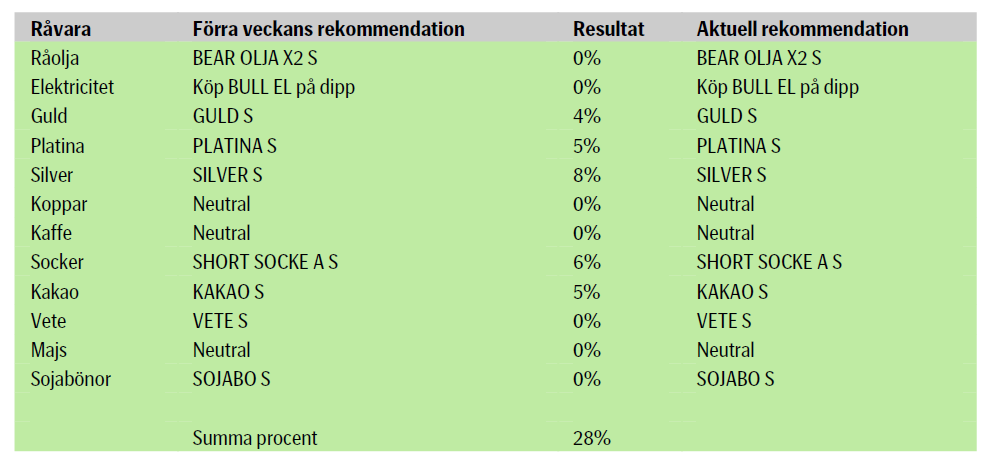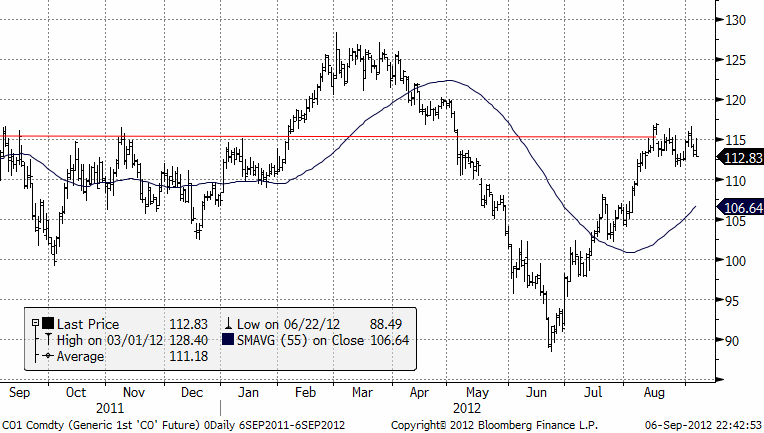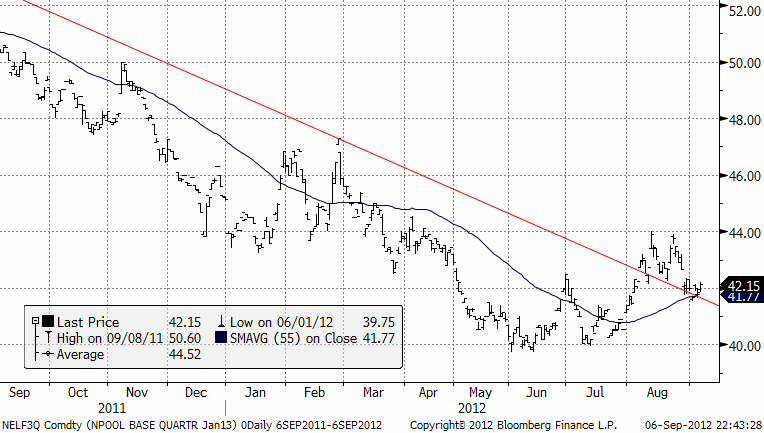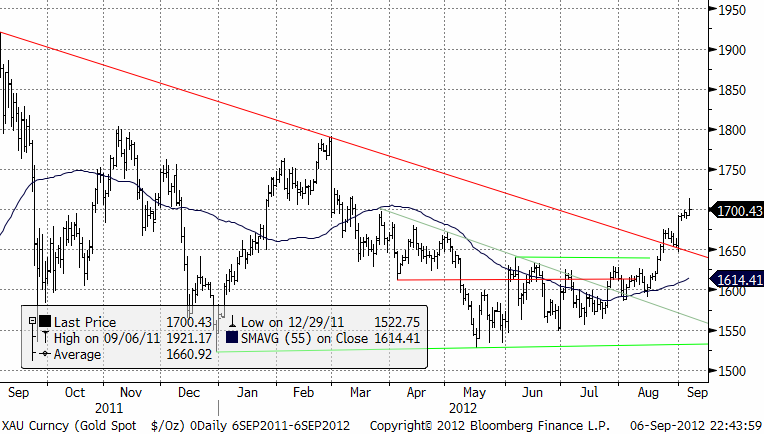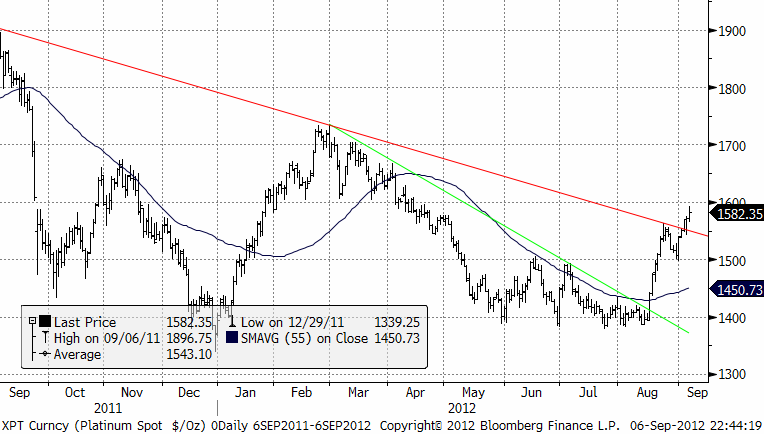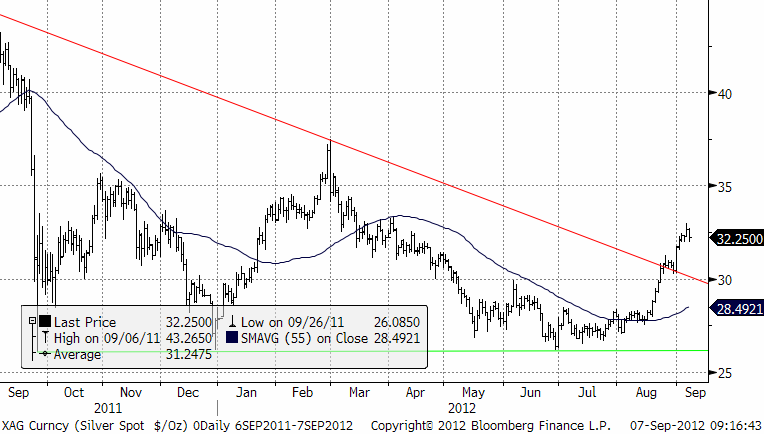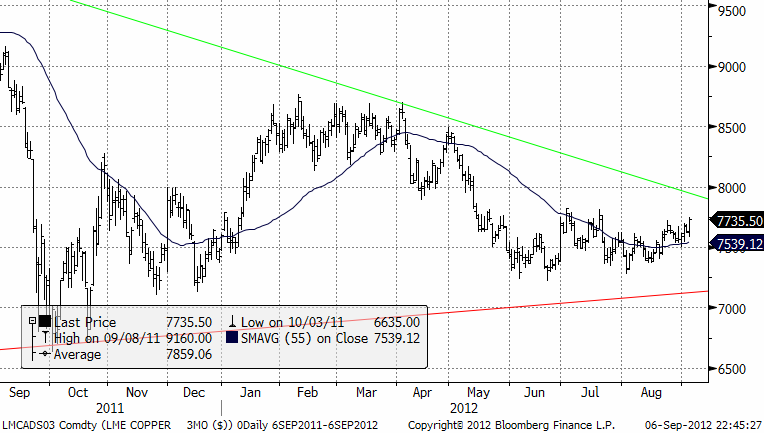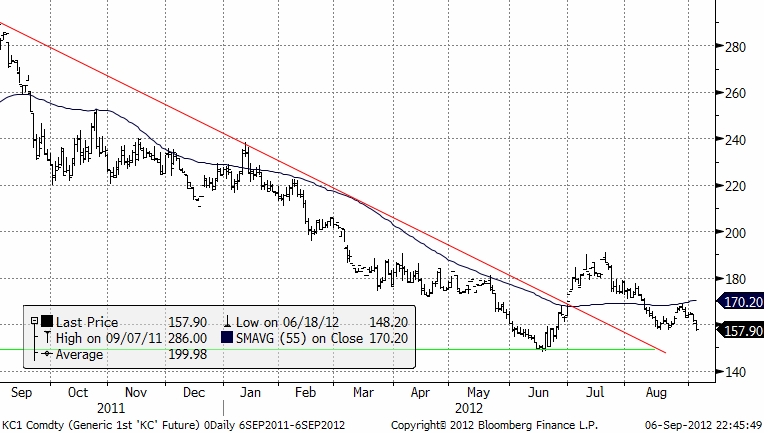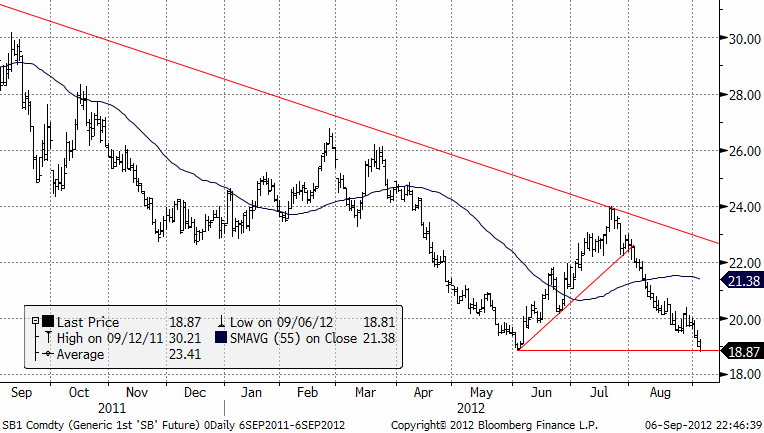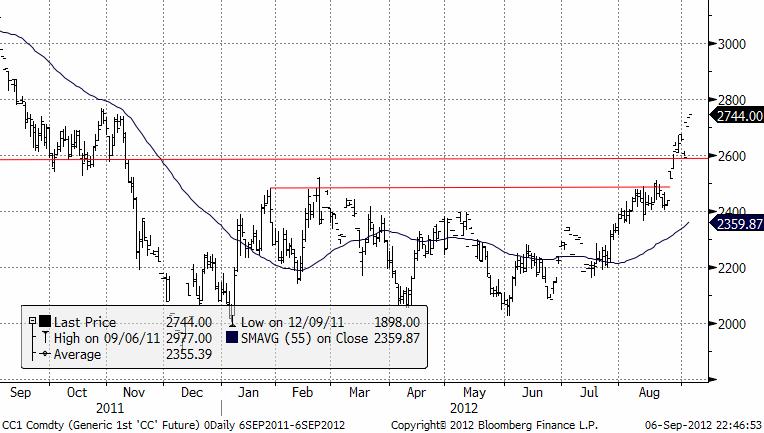Analys
SEB – Råvarukommentarer, 7 september 2012
Sammanfattning av rekommendationer
Även den här veckan har rekommendationerna varit vinstgivande.
Råolja – Brent
Uppgången in i motståndsområdet verkar ha kommit av sig, dock noteras även stöd i ett glidande 233-dagars genomsnittsband ($113.30 / 110.00), men skulle utbudet vara så stort att efterfrågan i detta området mättas så räknar vi med fall ner in i ett bredare ~$108 / 101 område. Nya toppar krävs nu för att minska den kortsiktiga nedåtrisken.
Vi tycker att oljeprisuppgången som inleddes i början av juli gick väl snabbt och kanske även väl högt men noterar att så länge utbudsstörningarna kvarstår, så är utbuds- och efterfrågebalansen tight, varför det är rimligt med ett brentpris i rangen 100-115 usd/fat. Vid nuvarande prisnivå kring 113 usd rekommendera vi en kort position. Även vår tekniska analys stöder en kort position. Man väljer t ex BEAR OLJA X2 S eller BEAR OLJA X4 S – om man vill ha hög hävstång.
Elektricitet
Elterminerna på elbörsen har sedan förra veckans kortrekommendation fallit 2.8% . I allt väsentligt kvarstår argumenten för nedsidan och i vissa delar har de även stärkts.
Priset befinner sig en bit från tidigare bottnar, vilka med den nuvarande fundamentala situationen, bör vara inom räckhåll.
Höstvädret blir avgörande för elpriset framöver då fyllnadsgraden i vattenmagasinen fortsatt är på 5-års högsta. Den gångna veckans nederbördsutfall har varit rikligt och prognoserna, vilka nu är starkt influerade av resterna av de stormsystem som tidigare svept in över USA:s syd- och östkust, visar på mycket stora mängder regn. Produktion i de svenska kärnkraftverken är på uppgång och på sina håll i södra Norge är det troligt att vattenkraftproducenter den närmaste tiden t o m tvingas ”spilla” vatten förbi turbinerna.
Vår syn på priset (lägre) på fossila bränslen som kol och naturgas är också oförändrad. Såvida inte vädersituationen ändras väsentligt inom den närmaste tiden tror vi därför att kontraktet som är underliggande för våra certifikat på el har fortsatt nedsida, varför kortrekommendationen kvarstår.
Guld, Silver och Platina
Ädelmetallerna går väldigt starkt och är tydligaste indikationen på marknadens förväntningar om stimulanspaket under hösten. Silver är vinnaren med en uppgång med 7 % sedan förra fredagen. Guld har stigit 3% medan Platina är upp 5 %. Trenderna är starka och stöds både av stimulansförväntningar och positiva tekniska signaler. Vi tror att komplexet har mer att ge. Ur ett kortsiktigt tekniskt perspektiv finns utrymme upp till $1800 (nu 1705) för guld, $ 35 (nu 32,60) för silver och $1700 (nu 1582) för Platina.
Vår favorit är Platina (t ex genom certifikatet PLATINA S, eller för den som vill ha lite mer hävstång, BULL PLATIN X4 S). Nedan ser vi platinaprisets utveckling, där brottet av den långsiktiga motståndslinjen, signalerar att den långa konsolideringsperioden är bruten, på uppsidan!
Nedan ser vi silverprisets kursutveckling. Det är samma starka tekniska köpsignal i den här metallen.
Koppar
Bernanke’s tal förra veckan gav inte några nya indikationer. De penningpolitiska stimulanserna kanske dröjer någon månad till. Blickarna vändes istället mot ECB:s räntebesked idag torsdag. Draghi bekräftade obligationsköp. Det var det som marknaden ville höra och priserna steg. Basmetaller har gått starkt i veckan och är upp mellan 2 och 3 %. Veckan inleddes annars med Kinas index är nu under den psykologiska 50-nivån. Negativa siffror således och basmetaller brukar följa ISM, men inte nu paradoxalt nog. Aktörerna väljer att se dem som en bekräftelse att Kina måste göra någonting. Frågan är bara vad och hur mycket.
Kopparpriset är nu tillbaka i den övre delen av trading-intervallet. Antalet utestående terminskontrakt på LME är fortfarande ovanligt lågt, den lägsta nivå sen i början av 2009. Det visar hur osäkra aktörerna är. De vill inte ta några stora positioner just nu. Så länge vi är kvar i intervallet erbjuds intressanta tradingmöjligheter, mellan $7300 och $7700, men med viss försiktighet när marknaden når brytpunkterna.
Vi väljer att fortsätta rekommendera köp av KOPPAR S.
Kaffe
Priset på Arabica, som handlas i New York, har fortsatt att falla i pris och vi undrar om inte utbrottet från trendlinjen var falskt. Skörden av Robusta i Vietnam har drabbats av torka. Det huvudsakliga odlingsområdet Dak Lak har fått 4.6 mm regn de senaste tio dagarna mot 22 normalt och förra året. Robusta-lagren i London har fallit med 65% sedan toppen i juli. Enligt en survey gjord av Bloomberg kan skörden minska med 10% från förra året. Coffee Network, en del av FC Stone, råvaruhandlaren, förutspår att utbudet bara överträffar efterfrågan med 500,000 säckar nästa år. En säck grönt kaffe väger 60 kilo.
Det är möjligt att kaffepriset håller på att etablera en botten med 1.50 dollar som stödnivå. Man bör kunna bottenfiska KAFFE S på de här nivåerna och sedan vänta in prisuppgångar i framtiden.
Socker
Priset på socker har studsat upp från strax under 20 cent och ligger nu på nästan exakt 20 cent. Trenden är ner, men trenden är också gammal.
Kakao
Vi skrev förra veckan att vi skulle vilja vara långa kakao om nivån 2500 dollar bröts. Den bröts i veckan och vi är därför långa KAKAO S. Västafrika har drabbats av torka. De kommande 30 dagarnas väder blir avgörande för skörden i Elfenbenskusten, som tävlar med Ghana om att vara världens största producenter.
För spannmål och övriga jordbruksprodukter hänvisas till gårdagens nyhetsbrev.
[box]SEB Veckobrev Veckans råvarukommentar är producerat av SEB Merchant Banking och publiceras i samarbete och med tillstånd på Råvarumarknaden.se[/box]
Disclaimer
The information in this document has been compiled by SEB Merchant Banking, a division within Skandinaviska Enskilda Banken AB (publ) (“SEB”).
Opinions contained in this report represent the bank’s present opinion only and are subject to change without notice. All information contained in this report has been compiled in good faith from sources believed to be reliable. However, no representation or warranty, expressed or implied, is made with respect to the completeness or accuracy of its contents and the information is not to be relied upon as authoritative. Anyone considering taking actions based upon the content of this document is urged to base his or her investment decisions upon such investigations as he or she deems necessary. This document is being provided as information only, and no specific actions are being solicited as a result of it; to the extent permitted by law, no liability whatsoever is accepted for any direct or consequential loss arising from use of this document or its contents.
About SEB
SEB is a public company incorporated in Stockholm, Sweden, with limited liability. It is a participant at major Nordic and other European Regulated Markets and Multilateral Trading Facilities (as well as some non-European equivalent markets) for trading in financial instruments, such as markets operated by NASDAQ OMX, NYSE Euronext, London Stock Exchange, Deutsche Börse, Swiss Exchanges, Turquoise and Chi-X. SEB is authorized and regulated by Finansinspektionen in Sweden; it is authorized and subject to limited regulation by the Financial Services Authority for the conduct of designated investment business in the UK, and is subject to the provisions of relevant regulators in all other jurisdictions where SEB conducts operations. SEB Merchant Banking. All rights reserved.
Analys
Tightening fundamentals – bullish inventories from DOE

The latest weekly report from the US DOE showed a substantial drawdown across key petroleum categories, adding more upside potential to the fundamental picture.

Commercial crude inventories (excl. SPR) fell by 5.8 million barrels, bringing total inventories down to 415.1 million barrels. Now sitting 11% below the five-year seasonal norm and placed in the lowest 2015-2022 range (see picture below).
Product inventories also tightened further last week. Gasoline inventories declined by 2.1 million barrels, with reductions seen in both finished gasoline and blending components. Current gasoline levels are about 3% below the five-year average for this time of year.
Among products, the most notable move came in diesel, where inventories dropped by almost 4.1 million barrels, deepening the deficit to around 20% below seasonal norms – continuing to underscore the persistent supply tightness in diesel markets.
The only area of inventory growth was in propane/propylene, which posted a significant 5.1-million-barrel build and now stands 9% above the five-year average.
Total commercial petroleum inventories (crude plus refined products) declined by 4.2 million barrels on the week, reinforcing the overall tightening of US crude and products.


Analys
Bombs to ”ceasefire” in hours – Brent below $70

A classic case of “buy the rumor, sell the news” played out in oil markets, as Brent crude has dropped sharply – down nearly USD 10 per barrel since yesterday evening – following Iran’s retaliatory strike on a U.S. air base in Qatar. The immediate reaction was: “That was it?” The strike followed a carefully calibrated, non-escalatory playbook, avoiding direct threats to energy infrastructure or disruption of shipping through the Strait of Hormuz – thus calming worst-case fears.

After Monday morning’s sharp spike to USD 81.4 per barrel, triggered by the U.S. bombing of Iranian nuclear facilities, oil prices drifted sideways in anticipation of a potential Iranian response. That response came with advance warning and caused limited physical damage. Early this morning, both the U.S. President and Iranian state media announced a ceasefire, effectively placing a lid on the immediate conflict risk – at least for now.
As a result, Brent crude has now fallen by a total of USD 12 from Monday’s peak, currently trading around USD 69 per barrel.
Looking beyond geopolitics, the market will now shift its focus to the upcoming OPEC+ meeting in early July. Saudi Arabia’s decision to increase output earlier this year – despite falling prices – has drawn renewed attention considering recent developments. Some suggest this was a response to U.S. pressure to offset potential Iranian supply losses.
However, consensus is that the move was driven more by internal OPEC+ dynamics. After years of curbing production to support prices, Riyadh had grown frustrated with quota-busting by several members (notably Kazakhstan). With Saudi Arabia cutting up to 2 million barrels per day – roughly 2% of global supply – returns were diminishing, and the risk of losing market share was rising. The production increase is widely seen as an effort to reassert leadership and restore discipline within the group.
That said, the FT recently stated that, the Saudis remain wary of past missteps. In 2018, Riyadh ramped up output at Trump’s request ahead of Iran sanctions, only to see prices collapse when the U.S. granted broad waivers – triggering oversupply. Officials have reportedly made it clear they don’t intend to repeat that mistake.
The recent visit by President Trump to Saudi Arabia, which included agreements on AI, defense, and nuclear cooperation, suggests a broader strategic alignment. This has fueled speculation about a quiet “pump-for-politics” deal behind recent production moves.
Looking ahead, oil prices have now retraced the entire rally sparked by the June 13 Israel–Iran escalation. This retreat provides more political and policy space for both the U.S. and Saudi Arabia. Specifically, it makes it easier for Riyadh to scale back its three recent production hikes of 411,000 barrels each, potentially returning to more moderate increases of 137,000 barrels for August and September.
In short: with no major loss of Iranian supply to the market, OPEC+ – led by Saudi Arabia – no longer needs to compensate for a disruption that hasn’t materialized, especially not to please the U.S. at the cost of its own market strategy. As the Saudis themselves have signaled, they are unlikely to repeat previous mistakes.
Conclusion: With Brent now in the high USD 60s, buying oil looks fundamentally justified. The geopolitical premium has deflated, but tensions between Israel and Iran remain unresolved – and the risk of missteps and renewed escalation still lingers. In fact, even this morning, reports have emerged of renewed missile fire despite the declared “truce.” The path forward may be calmer – but it is far from stable.
Analys
A muted price reaction. Market looks relaxed, but it is still on edge waiting for what Iran will do

Brent crossed the 80-line this morning but quickly fell back assigning limited probability for Iran choosing to close the Strait of Hormuz. Brent traded in a range of USD 70.56 – 79.04/b last week as the market fluctuated between ”Iran wants a deal” and ”US is about to attack Iran”. At the end of the week though, Donald Trump managed to convince markets (and probably also Iran) that he would make a decision within two weeks. I.e. no imminent attack. Previously when when he has talked about ”making a decision within two weeks” he has often ended up doing nothing in the end. The oil market relaxed as a result and the week ended at USD 77.01/b which is just USD 6/b above the year to date average of USD 71/b.

Brent jumped to USD 81.4/b this morning, the highest since mid-January, but then quickly fell back to a current price of USD 78.2/b which is only up 1.5% versus the close on Friday. As such the market is pricing a fairly low probability that Iran will actually close the Strait of Hormuz. Probably because it will hurt Iranian oil exports as well as the global oil market.
It was however all smoke and mirrors. Deception. The US attacked Iran on Saturday. The attack involved 125 warplanes, submarines and surface warships and 14 bunker buster bombs were dropped on Iranian nuclear sites including Fordow, Natanz and Isfahan. In response the Iranian Parliament voted in support of closing the Strait of Hormuz where some 17 mb of crude and products is transported to the global market every day plus significant volumes of LNG. This is however merely an advise to the Supreme leader Ayatollah Ali Khamenei and the Supreme National Security Council which sits with the final and actual decision.
No supply of oil is lost yet. It is about the risk of Iran closing the Strait of Hormuz or not. So far not a single drop of oil supply has been lost to the global market. The price at the moment is all about the assessed risk of loss of supply. Will Iran choose to choke of the Strait of Hormuz or not? That is the big question. It would be painful for US consumers, for Donald Trump’s voter base, for the global economy but also for Iran and its population which relies on oil exports and income from selling oil out of that Strait as well. As such it is not a no-brainer choice for Iran to close the Strait for oil exports. And looking at the il price this morning it is clear that the oil market doesn’t assign a very high probability of it happening. It is however probably well within the capability of Iran to close the Strait off with rockets, mines, air-drones and possibly sea-drones. Just look at how Ukraine has been able to control and damage the Russian Black Sea fleet.
What to do about the highly enriched uranium which has gone missing? While the US and Israel can celebrate their destruction of Iranian nuclear facilities they are also scratching their heads over what to do with the lost Iranian nuclear material. Iran had 408 kg of highly enriched uranium (IAEA). Almost weapons grade. Enough for some 10 nuclear warheads. It seems to have been transported out of Fordow before the attack this weekend.
The market is still on edge. USD 80-something/b seems sensible while we wait. The oil market reaction to this weekend’s events is very muted so far. The market is still on edge awaiting what Iran will do. Because Iran will do something. But what and when? An oil price of 80-something seems like a sensible level until something do happen.
-

 Nyheter4 veckor sedan
Nyheter4 veckor sedanStor uppsida i Lappland Guldprospekterings aktie enligt analys
-

 Nyheter4 veckor sedan
Nyheter4 veckor sedanSilverpriset släpar efter guldets utveckling, har mer uppsida
-

 Nyheter3 veckor sedan
Nyheter3 veckor sedanUppgången i oljepriset planade ut under helgen
-

 Nyheter3 veckor sedan
Nyheter3 veckor sedanLåga elpriser i sommar – men mellersta Sverige får en ökning
-

 Nyheter2 veckor sedan
Nyheter2 veckor sedanMahvie Minerals växlar spår – satsar fullt ut på guld
-

 Analys3 veckor sedan
Analys3 veckor sedanVery relaxed at USD 75/b. Risk barometer will likely fluctuate to higher levels with Brent into the 80ies or higher coming 2-3 weeks
-

 Nyheter1 vecka sedan
Nyheter1 vecka sedanOljan, guldet och marknadens oroande tystnad
-

 Nyheter1 vecka sedan
Nyheter1 vecka sedanJonas Lindvall är tillbaka med ett nytt oljebolag, Perthro, som ska börsnoteras



